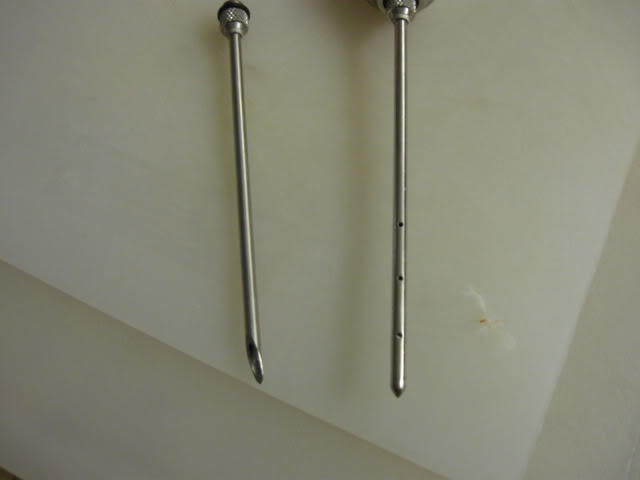Injecting 10% (weight of the meat) of the brine in the meat..... 10#'s of meat and 1# of brine (pint) evenly throughout the meat... space the injections what seems appropriate... That will help the meat get evenly cured or even spice/salt etc. distribution.. Trying to "dry brine" a piece of meat over 2" thick, and get an even internal distribution of "stuff" is not likely... You should still turn the meat and stir the brine every few days... I have read where the solutes in the brine will separate over time and mixing is necessary...
Dave
"Injecting" the meat can mean a couple things - are you using a needle injector or a broadcast injector?
The injector (or Artery) needle is on the left and has one straight outlet shooting the brine into the meat in a straight line. For this type of injection, you have to space the injections close together as the brine will only soak in to the meat in a straight line.
The broadcast needle is on the right. There are holes in 360° around the needle, so the brine shoots out perpendicular to the needle, covering a much wider area and enters the meat in a wide path. This is a much better application for injecting. The straight method is ok, but you have to inject it up to 4 times as much.
I have cured literally tons of meat and have never had to stir the brine. The ingredients remain in suspension just fine. When making it, I use cold water, add the ingredients and stir it until it becomes clear, then add the meat and don't touch it again until it's done curing. It will often get thicker and turn red from the blood, but that is perfectly normal.
++++++++++++++++++
Pops, evening.... I thought I covered the "injection" part of the discussion pretty well using a "descriptive" discussion.... I think that makes some sense that most folks can understand fairly easily, and get good results that will provide a safe product....
Injecting 10% (weight of the meat) of the brine in the meat..... 10#'s of meat and 1# of brine (pint) evenly throughout the meat... space the injections what seems appropriate... That will help the meat get evenly cured or even spice/salt etc. distribution..
+++++++++++++++++++
About stirring a pickle solution..... It may not be necessary...... And they may stay in suspension just fine..... In one of my many "trying to get educated" reading sessions, I did run across this description of why to "agitate or stir or mix" the pickle/brine/cure solution, and to mix/overhaul/rearrange meats in that solution...... Now I ain't no genius and have had ZERO training in the food service industry, but I do a fair amount of reading to try and educate myself..... and when a publication states, " It is a good idea to do this because........" .... and it makes sense to me.... and I don't see any harm in it..... (especially something as simple as stirring brine) and I ain't in the mood to try and prove them wrong....... I take it as good information and pass it on for folks to "take it or leave it".... Mixing up the meat causes no harm.... stirring the brine causes no harm.... and it may do some good..... So I pass it on... Below is an excerpt from that bulletin.....
http://www.meatsandsausages.com/sausage-making/curing/methods .....
++++++++++++++++++++
The wet curing method or immersion curing has been traditionally used for larger cuts of meat like butts or hams that were smoked. It is accomplished by placing meats in a wet curing solution (water, salt, nitrites, sugar). Sugar is added only when curing at refrigerator temperatures, otherwise it will begin fermentation and start spoiling the meat. Wet curing is used to preserve meat, add curing flavor and provide pink color to the meat. After wet curing the meats are normally smoked.
Most meat cuts require about 3 – 14 days of curing time even at 40° F (4° C). It is still a fine curing method for smaller cuts of meat that will have a shorter curing time. To distribute evenly the curing solution at the half curing time the meats have to be turned over (top pieces placed at the bottom and vice versa) and prevented from swimming up to the surface.
The reason being that salt has a tendency to sink to the bottom and nitrates/nitrites like to swim up to the top. The curing solution is not uniform and it has to be agitated once in a while otherwise meats will not be cured evenly. During that time we have to scoop up the foam and any slime that might gather on the surface, as that might be a source of contamination.
Using this method, large pieces of meat like hams need to remain in solution for up to 6 weeks and with such a long curing time there is a danger of meat spoiling from within the center where the bone is located. That is why it is much safer to shorten curing times by applying combination curing (stitch pumping plus wet cure) when curing large pieces of meat.
There are two ways of applying wet cure into meats
1.Immersing meat in curing solution (water, salt and nitrite)
2.Spray pumping meats with needles and curing solution







